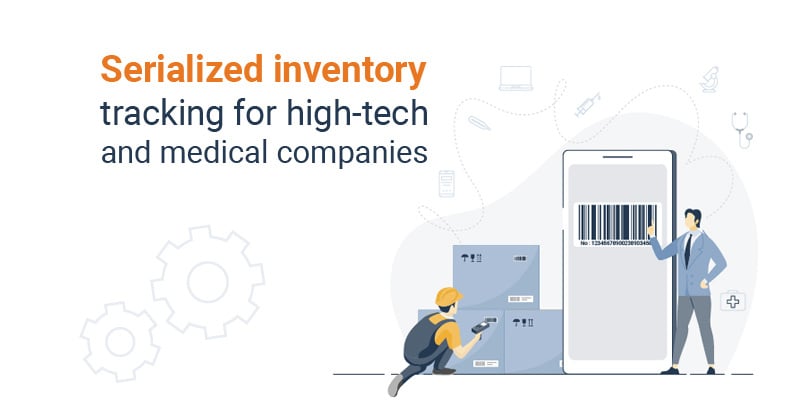5 Benefits of Serialized Inventory Tracking for High-tech and Medical Companies
 Cor Tiemens
Cor Tiemens
Table of contents
In today’s world, millions of products from high-tech and medical companies rely on the usage of chips or semiconductors.
However, the increased dependency on chips for each product has resulted in a chip shortage as the demand surpasses the supply. This has translated into a unique challenge for all companies utilizing chips – especially businesses involved in manufacturing high-tech and medical products.
Manufacturing businesses have been forced to increase the quality of the current stock of chips they own and extend the life of their chip-based devices and products through well-managed and maintained inventory.
With over 17 years of experience in the manufacturing and rental industries, we at STAEDEAN have seen various businesses go through different trends and empowered them to stay ahead of the curve by leveraging the right technology and software embedded in Microsoft Dynamics 365 ERP.
This article will share how high-tech and medical companies can beat the challenge of the global chip shortage by effectively managing their inventory through serialization.
What is serialized tracking of inventory?
Serialized inventory tracking is tracking items in your inventory (which you either rent or sell) by assigning each product within your inventory with a unique serial number. It is more than using a traditional SKU for a product as it allows you to track each product as an individual item, making it easier to manage warranties or guarantees associated with your products.
Below you can see the journey of a laptop, scanned through each stage of the supply chain:
Why do high-tech, medical, and chip-based device companies need to track inventory serially?
The chip shortage which hit the international manufacturing market is a big reason for companies in the high-tech and medical industries to adopt serialization of their inventory. Serially tracked inventory gives you greater control over your inventory as you can track and trace your product’s journey through each phase of the lifecycle.
Additionally, it’s no news that high-tech and medical device manufacturers are heavily regulated, dealing with products of high value, making serialization a necessity.
What are the benefits of serialized tracking of high-tech and medical devices?
1. Track the item through its lifecycle — from the design to build
With serialization, you can get a comprehensive understanding of the entire lifecycle of any product in your manufacturing business. It provides you with details about when a particular product was manufactured and sold, how many times it was serviced and maintained, what kind of operating system it runs on, and so on.
You can track your inventory through the design, production, testing, distribution, and maintenance phases. This makes it easier to manage issues around quality control and avoid shipping defective products.
Additionally, if defective items do get out, then product recalls are simpler and quicker as you could use the serial numbers to recall specific products instead of executing a blanket recall.
2. Easier to repair and manage warranties in case of any claims
As there is a serial number assigned to each product, you can know all the information about the product with its serial number.
Products such as cell phones, laptops, PCs, or medical devices such as oxygen machines, ECG equipment, scanning devices, and so on, have comprehensive warranties and guarantees attached to them.
The serial number tells you when you’ve sold the product, making any issues related to warranty repairs easy as you can determine the valid warranty period for the customer.
This makes the maintenance of your devices much easier as you always have the product history accessible before you carry out any repair activities on the product.
3. Comply with government regulations
Some countries or locations have government laws and regulations mandating serial numbers for tracking products. This is especially true in the case of drug manufacturing or biotech companies.
Each medical product must be serialized to ease issues around tracking, recalls, or counterfeiting.
Some examples of government regulations mandating serialization of medical products include:
- The Food and Drug Administration (FDA) mandates manufacturers to track certain devices through the entire distribution chain when and if they receive an order from the FDA to implement a tracking system. These devices could belong to Class I, Class II, or Class III devices.
- The federal Drug Supply Chain Security Act (DSCSA) of 2013 established a system to track and trace prescription drugs with a longer aim to track unit-level traceability throughout the United States supply chain.
- The European Union Medical Device Regulation (EU MDR) set of regulations of May 2021 aims to improve the safety and performance of medical devices throughout their lifecycle. The regulation plans to enhance the coordination of information on medical devices with better transparency and information access in the EU member states.
4. Preserve proof of ownership and prevent thefts
Serial numbers being unique, can easily be used to prove ownership of products, especially in the cases of loss or theft. This acts as a form of security for companies using serialization.
For instance, if a laptop is stolen from a retailer, the serial number is scanned every time the laptop moves from one location to another. The serial number has details of the origin attached to it, and this helps in returning the stolen product to the rightful owner or manufacturing company.
5. Detect counterfeit products and ensure quality
Serialization prevents other competitors or malicious businesses in the market from swapping and selling inferior products — as your products are identified through the unique serial number.
This is critical for medical device companies as it’s a matter of a person’s life, and manufacturers must be able to ensure accountability for each product from their company.
This allows you to ensure the quality of your products and secure delivery of your goods from the point of dispatch until the product reaches the end customer.
Your customers will also be happy to use your products, as they know that the product delivered has not been tampered with, is original, and of the highest quality.
What kind of technology can support the serialization of inventory for high-tech and medical companies?
By now, you’ve understood the significance of serialized tracking of your inventory. However, it’s critical to note that serialization cannot be executed efficiently without the proper technology in place.
High-tech, medical, and chip-based device companies should invest in an enterprise resource planning (ERP) system to begin their serialization journey.
You should look for an ERP system that supports and offers:
- Equipment as ‘fixed asset’ and defined ownership
- Barcode scanning to scan the barcodes on each of the manufactured product
- Mobility, as most of the equipment and devices are in the field and need quick resolutions related to servicing or maintenance by the field technicians
- Real-time connectivity to the ERP system for getting all the device information
- Dashboard of information with real-time analytics and KPIs offering useful information related to products, such as the status and location of every serialized device
- Visibility to the customers and devices associated with the customer — which could be achieved through serialized tracking of the client address, geocoding, or GPS tracking of the product (This is extremely helpful for tracking devices in remote locations consisting of only latitude and longitudes with no real street address)
- Sync of the CRM and ERP to offer quicker quotes and strengthen customer relations
- Accurate and easy ordering through dedicated portals allowing customers to buy or rent devices and products
- Management of overdue rentals of your medical and high-tech devices by setting reminders before the expiration of the rental agreement
Ready to embrace serialization and manage your inventory more efficiently?
If you are a company manufacturing medical devices, high-tech equipment, or chip-based products, you must be curious to know how to get to the next step — adopting serialization with the right technology, in the most efficient and seamless manner.
Well, we have you covered! If your long-term business goal is to move to cloud-based ERP, offering end-to-end visibility into your product lifecycle as a lead-to-cash solution, you can explore our rental software, STAEDEAN Rental Management, embedded in Microsoft Dynamics 365 for Finance and Supply Chain Management.
There are various benefits a rental solution offers to high-tech and medical companies, and you can evaluate whether our solution could be one of your options, by checking out the factsheet.
The factsheet will share information on:
- The solution features and benefits
- The different industries the solution supports
- The features of each optional add-on solution
- How STAEDEAN Rental Management can support your business

